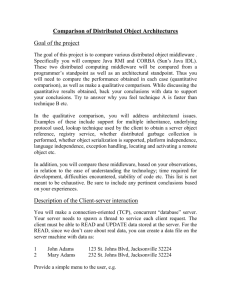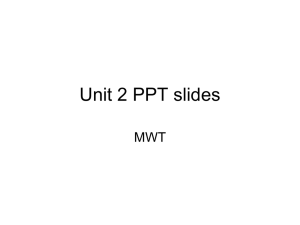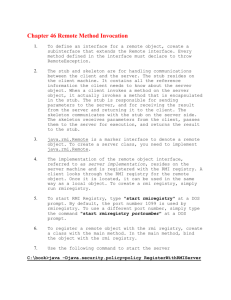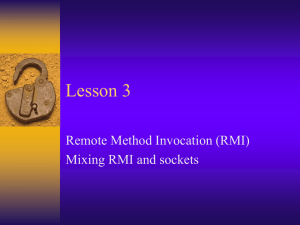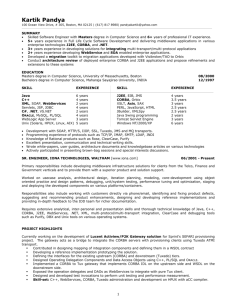Remote distributed objects
advertisement
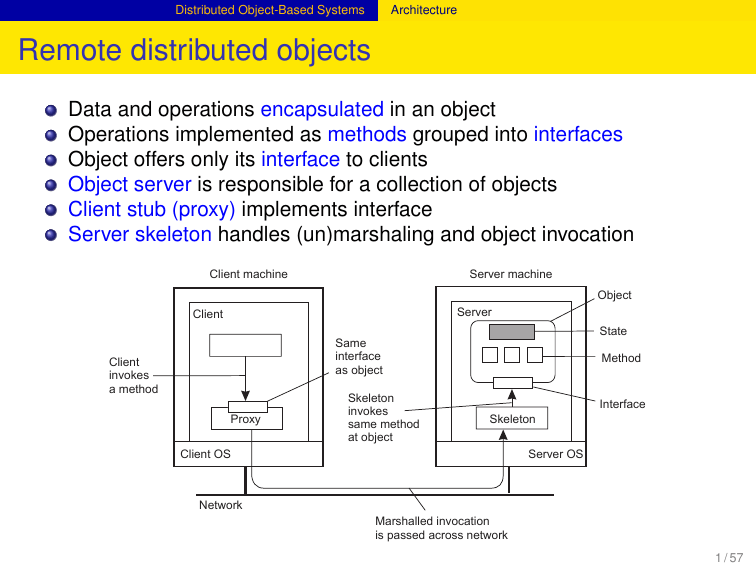
Distributed Object-Based Systems
Architecture
Remote distributed objects
Data and operations encapsulated in an object
Operations implemented as methods grouped into interfaces
Object offers only its interface to clients
Object server is responsible for a collection of objects
Client stub (proxy) implements interface
Server skeleton handles (un)marshaling and object invocation
Client machine
Server machine
Object
Server
Client
State
Same
interface
as object
Client
invokes
a method
Proxy
Skeleton
invokes
same method
at object
Method
Interface
Skeleton
Client OS
Server OS
Network
Marshalled invocation
is passed across network
1 / 57
Distributed Object-Based Systems
Architecture
Remote distributed objects
Types of objects I
Compile-time objects: Language-level objects, from which proxy
and skeletons are automatically generated.
Runtime objects: Can be implemented in any language, but
require use of an object adapter that makes the implementation
appear as an object.
Types of objects II
Transient objects: live only by virtue of a server: if the server exits,
so will the object.
Persistent objects: live independently from a server: if a server
exits, the object’s state and code remain (passively) on disk.
2 / 57
Distributed Object-Based Systems
Architecture
Example: Enterprise Java Beans (EJB)
What is it
Java object hosted by special server that allows for different means of
calling the object by remote clients.
Container
EJB
EJBEJB
Server
RMI
JDBC
JNDI
JMS
Services
Server kernel
Local OS
Network
3 / 57
Distributed Object-Based Systems
Architecture
Types of EJBs
Four different types
Stateless session bean: Transient object, called once, does its
work and is done. Example: execute an SQL query and return
result to caller.
Stateful session bean: Transient object, but maintains
client-related state until the end of a session. Example: shopping
cart.
Entity bean: Persistent, stateful object, can be invoked during
different sessions. Example: object maintaining client info on last
number of sessions.
Message-driven bean: Reactive objects, often triggered by
message types. Used to implement publish/subscribe forms of
communication.
4 / 57
Distributed Object-Based Systems
Architecture
Globe distributed objects
Observation
Most distributed objects are not distributed at all: state is kept at a
single node. Alternative: Globe objects, which are physically
distributed across multiple machines.
Distributed shared object
Local object
Process
Network
Interface
5 / 57
Distributed Object-Based Systems
Architecture
Globe distributed objects
Note
To make DSOs generic, we need to separate function from distribution
support
Same interface as implemented
by semantics subobject
Control
subobject
Replication
subobject
Semantics
subobject
Communication
subobject
Communication
with other local
objects
6 / 57
Distributed Object-Based Systems
Architecture
Globe distributed objects
Same interface as implemented
by semantics subobject
Control
subobject
Replication
subobject
Semantics
subobject
Communication
subobject
Communication
with other local
objects
Note
Replication subobject essentially decides how and when the local
semantics subobject will be invoked.
7 / 57
Distributed Object-Based Systems
Processes
Processes: Object servers
Servant
The actual implementation of an object, sometimes containing only
method implementations:
Collection of C or COBOL functions, that act on structs, records,
database tables, etc.
Java or C++ classes
Skeleton
Server-side stub for handling network I/O:
Unmarshalls incoming requests, and calls the appropriate servant
code
Marshalls results and sends reply message
Generated from interface specifications
8 / 57
Distributed Object-Based Systems
Processes
Processes: Object servers
Object adapter
The “manager” of a set of objects:
Inspects (as first) incoming requests
Ensures referenced object is activated (requires identification of
servant)
Passes request to appropriate skeleton, following specific
activation policy
Responsible for generating object references
9 / 57
Distributed Object-Based Systems
Processes
Processes: Object servers
Server with three objects
Server machine
Object's stub
(skeleton)
Observation
Object servers determine
how their objects are
constructed
Object adapter
Object adapter
Request
demultiplexer
Local OS
10 / 57
Distributed Object-Based Systems
Processes
Example: Ice
main(int argc, char* argv[]) {
Ice::Communicator ic;
Ice::ObjectAdapter adapter;
Ice::Object
object;
ic = Ice::initialize(argc, argv);
adapter = ic->createObjectAdapterWithEndPoints
( "MyAdapter","tcp -p 10000");
object = new MyObject;
adapter->add(object, objectID);
adapter->activate();
ic->waitForShutdown();
}
Note
Activation policies can be changed by modifying the properties
attribute of an adapter. Ice aims at simplicity, and achieves this partly
by putting policies into the middleware.
11 / 57
Distributed Object-Based Systems
Communication
Client-to-object binding
Object reference
Having an object reference allows a client to bind to an object:
Reference denotes server, object, and communication protocol
Client loads associated stub code
Stub is instantiated and initialized for specific object
Two ways of binding
Implicit: Invoke methods directly on the referenced object
Explicit: Client must first explicitly bind to object before invoking it
12 / 57
Distributed Object-Based Systems
Communication
Client-to-object binding: implicit/explicit
Distr object* obj ref;
obj ref = ...;
obj ref->do something();
Distr object* obj ref;
Local object* obj ptr;
obj ref = ...;
obj ptr = bind(obj ref);
obj ptr->do something();
Some remarks
Reference may contain a URL pointing to an implementation file
(Server,object) pair is enough to locate target object
We need only a standard protocol for loading and instantiating code
Observation
Remote-object references allow us to pass references as parameters. This
was difficult with ordinary RPCs.
13 / 57
Distributed Object-Based Systems
RMI
Remote Method Invocation (RMI)
The Java Remote Method Invocation (RMI) system allows an
object running in one Java Virtual Machine (VM) to invoke
methods on an object running in another Java VM.
Java RMI provides applications with transparent and lightweight
access to remote objects. RMI defines a high-level protocol and
API.
Programming distributed applications in Java RMI is simple.
It is a single-language system.
The programmer of a remote object must consider its behavior in a
concurrent environment.
14 / 57
Distributed Object-Based Systems
RMI
Remote Method Invocation (RMI)
RMI Architecture
Stub: lives on the client; pretends to be the remote object
Skeleton: lives on the server; talks to the true remote object
Reference Layer: determines if referenced object is local or
remote
Transport Layer: packages remote invocations; dispatches
messages between stub and skeleton
15 / 57
Distributed Object-Based Systems
RMI
Remote Method Invocation (RMI)
Java RMI Applications
A Java RMI application needs to do the following:
Locate remote objects: Applications can use one of two
mechanisms to obtain references to remote objects:
An application can register its remote objects with RMI’s simple
naming facility, the rmiregistry, or
the application can pass and return remote object references as
part of its normal operation.
Communicate with remote objects: Details of communication
between remote objects are handled by RMI; to the programmer,
remote communication looks like a standard Java method
invocation.
Load class bytecodes for objects that are passed around:
Because RMI allows a caller to pass objects to remote objects,
RMI provides the necessary mechanisms for loading an object’s
code, as well as for transmitting its data.
16 / 57
Distributed Object-Based Systems
RMI
Remote Method Invocation (RMI)
Java RMI Applications
RMI is supported by two java packages, java.rmi and java.rmi.server.
An application that uses RMI has 3 components:
an interface that declares headers for remote methods;
a server class that implements the interface; and
one or more clients that call the remote methods.
17 / 57
Distributed Object-Based Systems
RMI
Remote Method Invocation (RMI)
Basics
(Assume client stub and server skeleton are in place)
Client invokes method at stub
Stub marshals request and sends it to server
Server ensures referenced object is active:
Create separate process to hold object
Load the object into server process
...
Request is unmarshaled by object’s skeleton, and referenced method is
invoked
If request contained an object reference, invocation is applied recursively
(i.e., server acts as client)
Result is marshaled and passed back to client
Client stub unmarshals reply and passes result to client application
18 / 57
Distributed Object-Based Systems
RMI
RMI: Parameter passing
Object reference
Much easier than in the case of RPC:
Server can simply bind to referenced object, and invoke methods
Unbind when referenced object is no longer needed
Object-by-value
A client may also pass a complete object as parameter value:
An object has to be marshaled:
Marshall its state
Marshall its methods, or give a reference to where an
implementation can be found
Server unmarshals object. Note that we have now created a copy
of the original object.
Object-by-value passing tends to introduce nasty problems
19 / 57
Distributed Object-Based Systems
RMI
RMI: Parameter passing
Machine A
Local
reference L1
Client code with
RMI to server at C
(proxy)
Machine B
Local object
O1
Remote
reference R1
New local
reference
Remote object
O2
Copy of O1
Remote
invocation with
L1 and R1 as
parameters
Copy of R1 to O2
Machine C
Server code
(method implementation)
Note
Systemwide object reference generally contains server address, port to which
adapter listens, and local object ID. Extra: Information on protocol between
client and server (TCP, UDP, SOAP, etc.)
20 / 57
Distributed Object-Based Systems
RMI
RMI: Parameter passing
Machine A
Local
reference L1
Client code with
RMI to server at C
(proxy)
Machine B
Local object
O1
Remote
reference R1
New local
reference
Remote object
O2
Copy of O1
Remote
invocation with
L1 and R1 as
parameters
Copy of R1 to O2
Machine C
Server code
(method implementation)
Question
What’s an alternative implementation for a remote-object reference?
21 / 57
Distributed Object-Based Systems
RMI
RMI: Programming Applications
RMI Registry
the RMI registry is a simple server-side bootstrap naming facility
that allows remote clients to get a reference to a remote object
Servers name and register their objects to be accessed remotely
with the RMI Registry.
Clients use the name to find server objects and obtain a remote
reference to those objects from the RMI Registry.
A registry service is a background program that maintains a list of
registered server names on a host. It is invoked by:
rmiregistry port &
The registry service is provided by a Naming object that provides
two key methods:
bind to register a name and server
lookup to retrieve the server bound to a name
22 / 57
Distributed Object-Based Systems
RMI
RMI: Programming Applications
RMI Inheritance Hierarchy
23 / 57
Distributed Object-Based Systems
RMI
RMI: Programming Applications
Programming RMI Applications
The steps involved in programming an RMI application are:
Write a java interface that extends Remote. Each method in the
interface needs to declare that they throw RemoteException.
Write a server class that extends UnicastRemoteObject and
implements the methods in the interface.
Write code that instantiates the server and registers its name with
a registry service. This code can be in that main method of the
server class or within another class.
Write a client class that interacts with the server. The client then
calls Naming.lookup to get a reference to a server object from the
registry service. Once it has this reference the client can then
invoke the remote server’s methods.
24 / 57
Distributed Object-Based Systems
RMI
RMI: Programming Applications
An Example RMI Application
The files needed for creating a Java RMI application are:
A remote interface defines the remote interface provided by the
service. Usually, it is a few single line statements specifying the
service functions (DatabaseInterface.java). (An interface is the
skeleton for a public class.)
A remote object implements the remote service. It contains a
constructor and required functions. (Database.java)
The server offers the remote service, installs a security manager
and contacts rmiregistry with an instance of the service under the
name of the remote object. (DatabaseServer.java)
A client that invokes the remote method. (DatabaseClient.java)
25 / 57
Distributed Object-Based Systems
RMI
RMI: Programming Applications
DatabaseInterface.java
import java.rmi.*;
import java.rmi.server.*;
public interface DatabaseInterface extends Remote {
public int read() throws RemoteException;
public void write(int value) throws RemoteException;
}
26 / 57
Distributed Object-Based Systems
RMI
RMI: Programming Applications
Database.java
import java.rmi.*;
import java.rmi.server.*;
public class Database extends UnicastRemoteObject
implements DatabaseInterface {
private int data = 0; // the database
public Database(int value) throws RemoteException {
data = value;
}
public int read () throws RemoteException {
return data;
}
public void write (int value) throws RemoteException {
data = value;
System.out.println ("New value is: " + data);
}
}
27 / 57
Distributed Object-Based Systems
RMI
RMI: Programming Applications
DatabaseServer.java
import java.rmi.*;
import java.rmi.server.*;
public class DatabaseServer {
public static void main (Strings[] args) {
try {
// create Database Server Object
Database db = new Database(0);
// register name and start serving
String name = "rmi://fuji:9999/DB";
Naming.bind(name,db);
System.out.println (name + " is running");
} catch (Exception ex) {
System.err.println (ex);
}
}
}
28 / 57
Distributed Object-Based Systems
RMI
RMI: Programming Applications
DatabaseClient.java
import java.rmi.*;
public class DatabaseClient {
public static void main (String[] args) {
try {
// set RMI Security Manager
System.setSecurityManager(new RMISecurityManager() {
public void checkConnect(String host,int port) {}
public void checkConnect(String host,int port,Object Context) {}
});
// get database object
String name = "rmi://fuji:9999/DB";
DatabaseInterface db = (DatabaseInterface)Naming.lookup(name);
int value, rounds = Integer.parseInt(args[0]);
for (int i = 0; i < rounds; i++) {
value = db.read();
System.out.println("read: " + value);
db.write(value+1);
}
} catch (Exception ex) {
System.err.println (ex);
}
}
}
29 / 57
Distributed Object-Based Systems
RMI
RMI: Programming Applications
Building the Application
Compile the code:
javac Database.java DatabaseClient.java DatabaseInterface.java DatabaseServer.java
Generate stub and skeleton class files:
rmic Database (note: not needed for Java 5 or later)
Start the RMI registry:
rmiregistry 9999 &
Start the server:
java -Djava.security.policy=java.policy DatabaseServer
Run the client:
java -Djava.security.policy=java.policy DatabaseClient 10
30 / 57
Distributed Object-Based Systems
CORBA
CORBA: Overview
OMG
The Object Management Group (OMG) was formed in 1989 and now
has over 800 members. Its aims were:
to make better use of distributed systems
to use object-oriented programming
to allow objects in different programming languages to
communicate with one another
The object request broker (ORB) enables clients to invoke
methods in a remote object
CORBA (Common Object Request Broker Architecture) is a
specification of an architecture supporting this (rather than an
implementation such as RMI).
31 / 57
Distributed Object-Based Systems
CORBA
CORBA: Overview
ORB: the runtime system responsible for communication between
objects and their clients
CORBA facilities: collections of classes and objects that provide
general-purpose capabilities that are useful in many applications.
Horizontal facilities: user interfaces, information management,
system management, task management
Vertical facilities: e.g., electronic commerce, banking,
manufacturing, healthcare, telecommunications
32 / 57
Distributed Object-Based Systems
CORBA
CORBA: Components
Main CORBA Components
An Interface Definition Language (IDL) and its mapping onto the
implementation language (C, C ++, Java, Smalltalk, Ada, COBOL)
specifies the syntax of objects and services
cannot be used to describe semantics
object can be implemented by a language without classes
An Interface Repository (IR) representing the interfaces of all
objects available in the distributed system.
A fully dynamic calling mechanism allowing:
run-time discovery of objects
discovery of available interfaces from an IR
construction of message requests
sending of message requests
Object Adapters: an abstraction mechanism for removing
implementation details from the message substrate.
33 / 57
Distributed Object-Based Systems
CORBA
CORBA: Organisation
ORB offers:
Basic communication
Object references
Initial finding of services
Interfaces:
Static (described in IDL)
Run-time creation
(Dynamic Invocation
Interface)
34 / 57
Distributed Object-Based Systems
CORBA
CORBA: Communication
Request type
Synchronous
Failure semantics
At-most-once
One-way
Best effort delivery
Deferred
Synchronous
At-most-once
Description
Caller blocks until a response
is returned or an exception is
raised
Caller continues immediately
without waiting for any
response from the server
Caller continues immediately
and can later block
until response is delivered
35 / 57
Distributed Object-Based Systems
CORBA
CORBA: Event and Notification Services
Push-style model:
Pull-style model:
36 / 57
Distributed Object-Based Systems
CORBA
CORBA: Persistent Communication
CORBA messaging service:
Object-oriented approach to communication
All communication takes place by invoking an object
May not be possible to get an immediate reply
Callback model: A client features two interfaces: method and
callback
Polling model: A client is offered a collection of operations to poll
its ORB for incoming results
Messages sent are stored by the underlying system in case the
client or server is not yet running
37 / 57
Distributed Object-Based Systems
CORBA
CORBA: Messaging
Client application
1. Call by the
application
Client
proxy
Callback
interface
4. Call by the RTS
3. Response from server
Client
RTS
2. Request to server
Client application
1. Call by the
application
4. Call by the
application
Client
proxy
Polling
interface
3. Response from server
Client
RTS
2. Request to server
38 / 57
Distributed Object-Based Systems
CORBA
CORBA: Messaging Example
A Simple IDL Interface
For Callback/Polling, use special IDL compiler to transform original
(synchronous) method invocation into an asynchronouts one e.g.:
int add(in int i, in int j, out int k)
Two methods produced for Callback
void sendcb_add(in int i, in int j)
// called by client’s app
void replycb_add(in ret_val, in int k)
// called by client’s RTS/orb
i.e. replace both output args from add with 2 inputs to the callback.
Two methods produced for Polling
void sendpoll_add(in int i, in int j)
// called by client’s app
void replypoll_add(out ret_val, out int k)
// called by client’s app
39 / 57
Distributed Object-Based Systems
CORBA
CORBA: Object references
Observation
In order to invoke remote objects, we need a means to uniquely refer
to them.
Tagged Profile
Interoperable Object Reference (IOR)
Repository
identifier
Profile
ID
IIOP
version
Host
Adapter
identifier
Profile
Port
Object key
Object
identifier
Components
Other serverspecific information
40 / 57
Distributed Object-Based Systems
CORBA
CORBA: Object references
Observation
It is not important how object references are implemented per object-based
system, as long as there is a standard to exchange them between systems.
Object server
Object system A
Interoperable
references
(Half) gateway
Object system B
Solution
Object references passed from one RTS to another are transformed by the
bridge through which they pass (different transformation schemes can be
implemented)
41 / 57
Distributed Object-Based Systems
CORBA
CORBA: Object references
Object server
Object system A
Interoperable
references
(Half) gateway
Object system B
Observation
Passing an object reference refA from RTS A to RTS B circumventing
the A-to-B bridge may be useless if RTS B doesn’t understand refA
42 / 57
Distributed Object-Based Systems
CORBA
CORBA: Interoperability
Interoperability is achieved by the introduction of a standard
inter-ORB protocol (General Inter-ORB Protocol GIOP) which:
Defines an external data representation, called the Common Data
Representation (CDR)
Specifies formats for the messages in a request-reply protocol
including messages for enquiring about the location of an object, for
canceling requests and for reporting errors.
The Internet Inter-ORB protocol (IIOP) defines a standard form for
remote object references.
IIOP is GIOP implemented in TCP/IP
43 / 57
Distributed Object-Based Systems
CORBA
CORBA: Clients and Servers
Clients:
The IDL specification is compiled into a proxy
Proxy connects a client application to the underlying ORB
Servers:
The Portable Object Adapter (POA) makes code appear as CORBA
objects to clients
Creates remote object references for CORBA objects
Activates objects
Implements a specific activation policy (e.g., thread-per-request,
thread-per-connection, thread-per-object policy,...)
Methods are implemented by means of servants.
44 / 57
Distributed Object-Based Systems
CORBA
CORBA: Portable Object Adapters
Mapping of CORBA object identifiers to servants.
a) The POA supports multiple servants.
b) The POA supports a single servant.
45 / 57
Distributed Object-Based Systems
CORBA
CORBA: Programming Applications
Programming CORBA Applications
The steps involved in programming a CORBA application are:
Write the IDL interface file
Compile the IDL file to generate stubs and skeletons
Write and compile the remote object implementation
Write and compile the remote server
Write and compile the client
46 / 57
Distributed Object-Based Systems
CORBA
CORBA: Programming Applications
Example: a CORBA object with operation sayHello() returning a string.
Defining the Interface: Hello.IDL
module HelloApp
{
interface Hello
{
string sayHello();
};
};
To compile the IDL file to generate the stubs and skeletons:
idlj -fall Hello.idl
47 / 57
Distributed Object-Based Systems
CORBA
CORBA: Programming Applications
Files generated by idlj
Below is a UML diagram showing the files autogenerated by IDL.
48 / 57
Distributed Object-Based Systems
CORBA
CORBA: Programming Applications
This generates the following files:
HelloImplBase.java or HelloPOA.java: this abstract class is the
server skeleton, providing basic CORBA functionality for the
server. It implements the Hello interface. The server class
HelloServant extends HelloImplBase.
HelloStub.java: this class is the client stub, providing CORBA
functionality for the client. It implements the Hello interface.
HelloHelper.java: this final class provides auxiliary functionality,
notably the narrow method required to cast CORBA object
references to their proper types.
HelloHolder.java: this final class holds a public instance member
of type Hello. It provides operations for out and inout arguments,
which CORBA has but which do not map easily to Java’s
semantics.
49 / 57
Distributed Object-Based Systems
CORBA
CORBA: Programming Applications
HelloOperations.java: this interface contains the single method
sayHello(). The IDL-to-Java mapping puts all of the operations
defined on the IDL interface into this file, which is shared by both
the stubs and skeletons.
Hello.java: this interface contains the Java version of our IDL
interface. It contains the single method sayHello. The Hello
interface extends org.omg.CORBA.Object, providing standard
CORBA object functionality as well. Here is the generated
Hello.java file:
/* Hello.java as generated by idlj */
package HelloApp;
public interface Hello extends org.omg.CORBA.Object
{
String sayHello();
}
50 / 57
Distributed Object-Based Systems
CORBA
CORBA: Programming Applications
Implementing the Remote Object: HelloServant.java
public class HelloServant extends _HelloImplBase
{
public String sayHello()
{
return "\nHello world!!\n";
}
}
51 / 57
Distributed Object-Based Systems
CORBA
CORBA: Programming Applications
Implementing the Remote Server: HelloServer.java
// The package containing our stubs.
import HelloApp.*;
// HelloServer will use the naming service.
import org.omg.CosNaming.*;
// The package containing special exceptions thrown by the name service.
import org.omg.CosNaming.NamingContextPackage.*;
// All CORBA applications need these classes.
import org.omg.CORBA.*;
public class HelloServer {
public static void main(String args[]) {
try {
// Create and initialize the ORB
ORB orb = ORB.init(args, null);
// Create the servant and register it with the ORB
HelloServant helloRef = new HelloServant();
orb.connect(helloRef);
52 / 57
Distributed Object-Based Systems
CORBA
CORBA: Programming Applications
// Get the root naming context
org.omg.CORBA.Object objRef =
orb.resolve_initial_references("NameService");
NamingContext ncRef = NamingContextHelper.narrow(objRef);
// Bind the object reference in the root naming context
NameComponent nc = new NameComponent("Hello", "");
NameComponent path[] = nc;
ncRef.rebind(path, helloRef);
// Wait for invocations from clients
java.lang.Object sync = new java.lang.Object();
synchronized(sync) {
sync.wait();
}
} catch(Exception e) {
System.err.println("ERROR: " + e);
e.printStackTrace(System.out);
}
}
}
53 / 57
Distributed Object-Based Systems
CORBA
CORBA: Programming Applications
Implementing the Client: HelloClient.java
import HelloApp.*;
import org.omg.CosNaming.*;
import org.omg.CORBA.*;
public class HelloClient {
public static void main(String args[]) {
try {
// Create and initialize the ORB
ORB orb = ORB.init(args, null);
// Get the root naming context
org.omg.CORBA.Object objRef =
orb.resolve_initial_references("NameService");
NamingContext ncRef = NamingContextHelper.narrow(objRef);
54 / 57
Distributed Object-Based Systems
CORBA
CORBA: Programming Applications
// Resolve the object reference in naming
NameComponent nc = new NameComponent("Hello", "");
NameComponent path[] = nc;
Hello helloRef = HelloHelper.narrow(ncRef.resolve(path));
// Call the Hello server object and print results
String hello = helloRef.sayHello();
System.out.println(hello);
} catch(Exception e) {
System.out.println("ERROR : " + e);
e.printStackTrace(System.out);
}
}
}
55 / 57
Distributed Object-Based Systems
CORBA
CORBA: Programming Applications
Building the Application
Compile the .java files, including the stubs and skeletons (which
are in the directory HelloApp):
javac *.java HelloApp/*.java
Start the Java IDL name server:
tnameserv -ORBInitialPort 1050
Start the Hello server:
java HelloServer -ORBInitialPort 1050
Run the Hello application client:
java HelloClient -ORBInitialPort 1050
The client output:
Hello world!!
56 / 57
Distributed Object-Based Systems
CORBA
RMI vs CORBA
CORBA was designed for language independence whereas RMI
was designed for a single language where objects run in a
homogeneous environment
CORBA interfaces are defined in IDL, while RMI interfaces are
defined in Java
CORBA objects are not garbage collected because they are
language independent and they have to be consistent with
languages that do not support garbage collection, on the other
hand RMI objects are garbage collected automatically
57 / 57
